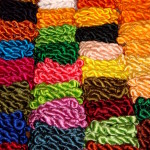Cashmere, silk, cotton and wool: the history and benefits of natural fabric mixes

Silk yarns
Silk is a stunning fabric, with many extraordinary properties. Although strong, breathable and hypoallergenic it is not always the ideal fabric for every item of clothing. And that is where the beauty of mixed fabrics comes in – by combining the impressive properties of silk with other all-natural yarns, such as cotton or cashmere, fabrics with combined features can be produced.
The history and origins of mixed fabrics

Traveling across the Silk Road
People around the globe have been hand-producing blended silk mixes for over 600 years. One of the first known silk mix was silk-cashmere, a wonderful amalgam of sheen and softness.
There are recorded examples of silk-cashmere production taking place in 15th century India. These fabrics were hand crafted by weaving together fine silk fibres with beautiful cashmere wool.
It is thought that the infamous Silk Road may have played a large part in the development of silk mixes. With amazing never-seen-before fabrics being traded for the first time, the possibility of combining one country’s luxury textile with another’s must have been hard to resist.

Silk yarns
It has been suggested that Royal Mongol rulers used the Silk Road to bring together wool from the Vale of Kashmir, fine Chinese silk and Turkmenistani master weavers to produce a fabric fit for the Mongol Dynasty.

Weaving the yarns
It wasn’t long before word of this new fabric got to Europe. Wealthy Europeans were so desperate to get hold of soft Kashmiri silk-cashmeres that by the early 19th century quick-shifting textile workshops were set up in Scotland, England and France to produce the fabric mix themselves.
Today, the production of mixed and blended fabrics usually takes place in large factories, where yarns and fibres can be combined on an industrial scale. Although it is shipped all over the world, the main production hasn’t travelled far from the days of the Silk Road, with most mixed fabrics made in China and India.
Production process
There are two principle methods to combining yarns and fibre: blending and mixing.
Blending works by combining different fibres as they are spun into a yarn. The more yarns you spin together the greater the density of resulting fabric will be. The main advantage of blending fibres together is that the yarn produced takes on the properties of both fibres.

(left to right): Yarn being converted onto reels, modern weaving machinery, silk reels ready for weaving
The second method is mixing. This process takes place during the weaving stage, when yarns are knitted together. Two or more different yarns, such as cotton and silk, are combined using the warp and weft construction of the fabric itself. The end fabric can have additional characteristics.
Silk mixes and blends
Silk can be blended or mixed with cashmere, wool and cotton.
One perfect partnership is silk-cotton. By blending these together the resultant fabric is one with a soft, delicate lustre but one that is more durable than silk alone. This blend is created as the two fibres are spun together to make a combined yarn, so the cotton may have the silk twisted on to it.
It can be a technical challenge and it is important to get it right to avoid the garment twisting when washed. Varying the ratio of silk to cotton produces fabrics with varying amounts of silk and cotton qualities.
Another combination is silk-jersey, when two silk yarns are mixed with one cotton yarn and Spandex yarn to get a fabric with the smoothness of silk, the easy-care of cotton and the additional bonus of Spandex’s elasticity.
Although very different fibres, cashmere and silk actually blend together very well. Silk is quite a tough fibre, so when blended with cashmere using a woollen system, the end result is not quite as soft a pure cashmere – but what is created is a breathable, lighter version of the wool – perfect for a summer’s evening.
Silk and wool is a luxurious textile that is warm but still retains a silky feel, making it an ideal choice in late summer and cooler days. More durable and warmer than silk alone, it makes for classic looking, lightweight jackets, suits and accessories.
Clever clothing
Once woven, these fascinating mixed or blended fabrics are made into beautiful items of clothing.

(from left to right) Silk and Cotton Shirt, Silk and Cotton Nightdress, Silk and Cotton Top
At Patra we love to use all-natural fabrics.
Our mixes take advantage of the outstanding properties of natural fibres to produce garments that are rich in characteristics and classically stylish.
Patra’s production of mixes and blends use high percentages of the purest fibres, and the end results are multi-faceted, versatile fabrics.
From lightweight, breathable underwear to super-soft warm knits – key pieces that work hard to keep you feeling good and looking your best all year round.



